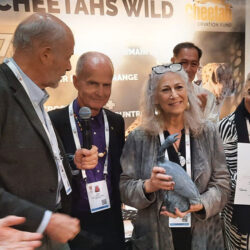Cheetah Conservation Funf Hosts Student Expedition as Part of National Geographic’s 125th Anniversary
-

- by CCF Staff July 17, 2013
FOR IMMEDIATE RELEASE
Contact: Dr. Laurie Marker (ph: 067- 306225, cell: 081-1247887) or Patricia Tricorache (cell: 081-458-6006)
CHEETAH CONSERVATION FUND HOSTS STUDENT EXPEDITION AS PART OF NATIONAL GEOGRAPHIC’S 125TH ANNIVERSARY
(Otjiwarongo, Namibia, 17 July 2013) – Visiting Cheetah Conservation Fund (CCF) was the culmination of a 21-day Namibian programme from National Geographic Student Expeditions. This expedition was one of three special student itineraries created to celebrate National Geographic’s 125th Anniversary. CCF is proud to be one of the very special projects supported by National Geographic’s Big Cats Initiative (BCI).
From 14 to 16 July, 23 youth between the ages of 16 and 18 learned from CCF field researchers aspects of cheetah husbandry and veterinary care, ecological research, and integrated predator-livestock management techniques, including predator identification and CCF’s famous Livestock Guarding Dog programme. Participants shadowed CCF’s experts in tasks including feeding CCF’s resident cheetahs cheetahs, looking after livestock and Livestock Guarding Dogs, and using scat-detection dogs to collect cheetah faeces for genetic analysis.
“The National Geographic Student Expeditions are so important, as they give youth a first-hand look at the importance of balanced eco-systems, and introduce them to the various aspects of field conservation –and what better place than Namibia, which harbours such a precious array of natural treasures,” said Dr. Laurie Marker, CCF’s Founder and Executive Director. “We are excited to think that the experiences of these young men and women, and especially their visit with us, will encourage them to eventually become the conservation leaders of tomorrow.”
Prior to their arrival at CCF, the group learned about rhino conservation in Damaraland and track leopards at N/a’an Ku Sê, which is also supported by the BCI. The students also visited other Namibian landmarks including the Etosha National Park, and the Namib Desert. Participants in National Geographic Student Expeditions utilise photography, film and other media to develop a special presentation that conveys the messages about conservation issues they encountered during the expedition.
Editor’s notes:
The Cheetah Conservation Fund (CCF) is a Namibian non-profit trust dedicated to the long-term survival of the cheetah and its ecosystems.
Since 1990, the organisation has developed education and conservation programmes based on its bio-medical cheetah research studies, published over 60 scientific research papers and has presented educational programmes to more than 300,000 outreach school learners, donated over 400 livestock guarding dogs to commercial and communal farmers as part of the CCF innovative non-lethal livestock management programme, and has established a cheetah genome resource bank of cheetah sperm, tissue and blood samples.
Research into cheetah biology and ecology has greatly increased our understanding of the fastest land animal and education programmes for schools and the farming community help change public attitudes to allow predator and humans to co-exist. However, despite the many successes of CCF programmes, the cheetah is still Africa’s most endangered big cat with ~10,000 cheetahs remaining.
For more information:
Cheetah Conservation Fund
PO Box 1755, Otjiwarongo – Namibia
Tel: (067) 306225
Fax: (067) 306247
E-mail: [email protected]
Website: www.cheetah.org
Related Reading


